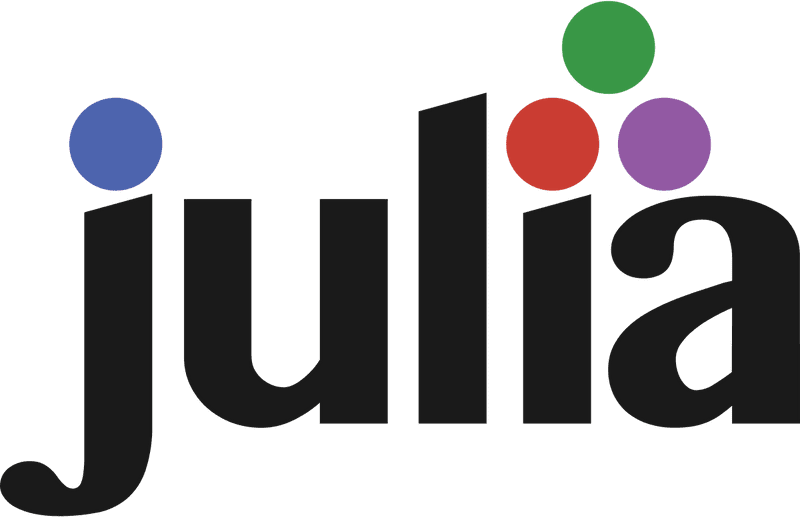Python’s popularity has grown significantly over the last decade in various domains, especially data analysis, data engineering, data science, and machine learning. But there’s another programming language on the scene. Julia is starting to gain a lot of traction, mainly due to its many benefits over Python.
In this article, we’ll discuss the Julia programming language, its history, features, and how it measures up against Python.
Will this be the end of Python? Let’s find out.
What is Julia?
Julia’s journey began in 2009 with the goal to create a new fast, high-level language. It was created by Jeff Bezanson, Viral B. Shah, Alan Edelman, and Stefan Karpinski. The creators wanted Julia to be as fast as C and as dynamic as Ruby. They also strove to build a general-purpose programming language like Python that is as useful and easy for statistics as R.
Julia’s creators open-sourced it in 2012. Since then, the programming language has built a huge developer community worldwide, quickly growing and improving. The latest version Julia 1.5.2 was released in September 2020.
Julia specifically targets domains such as data mining, machine learning, scientific computing, etc. Julia has joined Fortran, C, and C++ in the petaflops computing club of high-level languages. This makes Julia perfect for distributed and parallel computing.
8 key features of Julia
Here are some features of the Julia programming language:
- Julia uses the LLVM compiler, which makes Just-in-Time (JIT) compilation possible. This is the reason behind the performance of Julia, ensuring speeds close to the C programming language.
- Julia offers an interactive command-line interface like Python. Also, its syntax is similar to Python’s, which makes it easy to adapt and understand. Because of Julia’s syntax, it is suitable for general-purpose programming.
- Julia provides direct interface capabilities with libraries written in other programming languages, like C and Fortran. Also, Julia can interface with Python code.
- Julia features metaprogramming, which means one Julia program can generate another Julia program. It can even modify its own code. This comes from Julia’s inspiration, Lisp Macros (as recounted here).
- Julia offers the combined benefit of static and dynamic typing.
- Julia supports both functional and object-oriented programming.
- Starting with version 1.1, Julia supports a full-featured debugger.
- Julia is one of the first languages to make mathematical structures native. This means that vectors and matrices operations are part of the core language (along with math symbols).
Get To Know Other Data Science Students
Samuel Okoye
IT Consultant at Kforce
Isabel Van Zijl
Lead Data Analyst at Kinship
Pizon Shetu
Data Scientist at Whiterock AI
Julia vs. Python: Is Julia really better?
There are a number of advantages of using Julia over Python:
- It’s faster. As mentioned before, having JIT compilation capabilities makes Julia several times faster than the pure Python code. Julia is a compiled language, which means programs can be directly executed on a computer processor, whereas Python is an interpreted language.
- It has math-friendly syntax. Unlike Python, Julia features math-friendly syntax as it was designed with the scientific community in mind using R, Matlab, Octave, and so on. Mathematical expressions written in Julia resemble real math expressions, making it easy to grasp for the non-programming communities.
- It supports more refined parallel computing. Both Julia and Python support parallel computing. However, data must be serialized and deserialized between threads and nodes when implementing parallel operations in Python, whereas, for Julia, parallel programming is much more refined.
- It has native ML libraries. Julia provides many native machine learning libraries like MLJ.jl, Flux.jl, Knet.jl, AlpaZero.jl, Turing.jl etc. Because they are entirely written in Julia, it is easy for users to modify as needed.
Why Python won’t disappear anytime soon
Even though there are many benefits of using Julia over Python, Python will not disappear anytime soon. Here’s why:
- Julia is young; Python is mature. Julia was released publicly in 2012 while Python has been around for three decades.
- Community matters. At present, Python has millions of users around the world, and wildly popular among the Data Scientists, ML Engineers and Programmer whereas Julia’s community is small. This is important because a large community encourages great development and support.
- Python has many third-party libraries compared to Julia. This versatility makes Python more useful for almost any task like Data Analytics, Data Science, Machine Learning, Backend Development and so much more. This is why Python will be here to stay until Julia’s library ecosystem matures.
- As compared to Julia, Python has less startup overhead. Although Julia programs are faster than Python, Python’s runtime is lightweight compared to Julia’s. Because of this, Python programs take less time to start and produce first results.
Since you’re here…Are you interested in this career track? Investigate with our free guide to what a data professional actually does. When you’re ready to build a CV that will make hiring managers melt, join our Data Science Bootcamp which will help you land a job or your tuition back!






